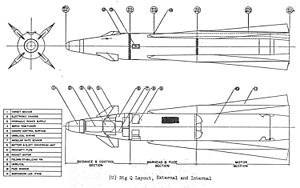Overview
The Big Q began life in 1963 as a replacement for the AIR-2 Genie rocket. The Genie was unguided, and had generally poor flight performance characteristics. The Big Q was to be a much more capable weapon, intended to engage Soviet bombers.
Big Q is actually a nickname only. The right to name the missile was given to the initial designer, 1st Lt John McMasters, who chose the name of the Aztec serpent god Quetzalcoatl. This led to a tremendous number of pronunciation and spelling errors until virtually everybody associated with the project referred to it as Big Q for short.
In 1965 the ZAIM-68A designation was assigned to the missile. A 20% model was successfully tested in a wind tunnel during that year and in June a contract was awarded to National Tapered Wing Engineering Company to produce 20 fuselage sections for prototype missiles.
The AIM-68 was designed with a dual-thrust solid-propellant rocket and was capable of reaching speeds of Mach 4 over its 65-kilometre (40 mi) range. The prototypes were fitted with infrared guidance systems from GAR-2A/B (AIM-4C/D) Falcon missiles; the rocket motor from the AGM-12 Bullpup was used for propulsion. The warhead was a W30 0.5 kiloton nuclear warhead, smaller than the 1.5 kiloton model used on the Genie. The guidance system allowed the missile to be used against maneuvering targets, including single bombers, rather than whole formations as was the case for the Genie. The reduced yield and greater range also made using the weapon a far less hazardous prospect for the launching aircraft.
Potential users of the Big Q included the F-101B, F-102A, F-106A, F-4C. The size of the missile was dictated by these choices, as some of the aircraft carried weapons in an internal bay. As part of the effort to keep the size down, the missile was fitted with fold-out sections on the main wings.
There have been attempts to reuse the -68 designation; notably the U.S. Navy wanted their new Standard Block V missile to be known as the RIM-68A. This failed (the designation RIM-156A was used instead). In 1995, the Navy tried to change it again—apparently wanting an operational missile to have a continuous run with the RIM-66 Standard MR and RIM-67 Standard ER designations. The request was refused again.
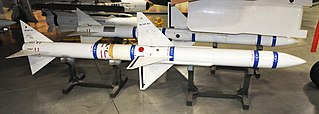
The AIM-7 Sparrow is an American medium-range semi-active radar homing air-to-air missile operated by the United States Air Force, United States Navy, United States Marine Corps, and various other air forces and navies. Sparrow and its derivatives were the West's principal beyond visual range (BVR) air-to-air missile from the late 1950s until the 1990s. It remains in service, although it is being phased out in aviation applications in favor of the more advanced AIM-120 AMRAAM.
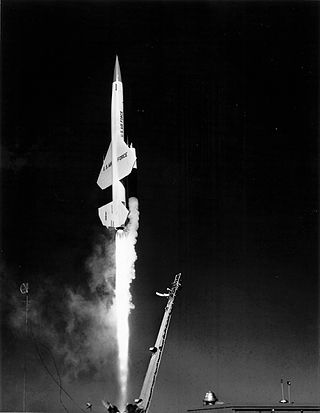
The Boeing CIM-10 BOMARC was a supersonic ramjet powered long-range surface-to-air missile (SAM) used during the Cold War for the air defense of North America. In addition to being the first operational long-range SAM and the first operational pulse doppler aviation radar, it was the only SAM deployed by the United States Air Force.

The Avro Blue Steel was a British air-launched, rocket-propelled nuclear armed standoff missile, built to arm the V bomber force. It allowed the bomber to launch the missile against its target while still outside the range of surface-to-air missiles (SAMs). The missile proceeded to the target at speeds up to Mach 3, and would trigger within 100 m of the pre-defined target point.

In military terminology, a missile is a guided airborne ranged weapon capable of self-propelled flight usually by a jet engine or rocket motor. Missiles are thus also called guided missiles or guided rockets. Missiles have five system components: targeting, guidance system, flight system, engine and warhead. Missiles come in types adapted for different purposes: surface-to-surface and air-to-surface missiles, surface-to-air missiles, air-to-air missiles, and anti-satellite weapons.
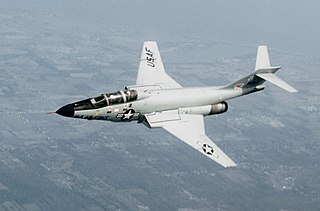
The McDonnell F-101 Voodoo is a supersonic jet fighter designed and produced by the American McDonnell Aircraft Corporation.

The Convair RIM-2 Terrier was a two-stage medium-range naval surface-to-air missile (SAM), among the earliest SAMs to equip United States Navy ships. It underwent significant upgrades while in service, starting with beam-riding guidance with a 10-nautical-mile (19 km) range at a speed of Mach 1.8 and ending as a semi-active radar homing (SARH) system with a range of 40 nmi (74 km) at speeds as high as Mach 3. It was replaced in service by the RIM-67 Standard ER (SM-1ER).

RIM-7 Sea Sparrow is a U.S. ship-borne short-range anti-aircraft and anti-missile weapon system, primarily intended for defense against anti-ship missiles. The system was developed in the early 1960s from the AIM-7 Sparrow air-to-air missile as a lightweight "point-defense" weapon that could be retrofitted to existing ships as quickly as possible, often in place of existing gun-based anti-aircraft weapons. In this incarnation, it was a very simple system guided by a manually aimed radar illuminator.

The Bristol Bloodhound is a British ramjet powered surface-to-air missile developed during the 1950s. It served as the UK's main air defence weapon into the 1990s and was in large-scale service with the Royal Air Force (RAF) and the forces of four other countries.

The North American XF-108 Rapier was a proposed long-range, high-speed interceptor aircraft designed by North American Aviation intended to defend the United States from supersonic Soviet strategic bombers. The aircraft would have cruised at speeds around Mach 3 with an unrefueled combat radius over 1,000 nautical miles, and was equipped with radar and missiles offering engagement ranges up to 100 miles (160 km) against bomber-sized targets.

The Douglas AIR-2 Genie was an unguided air-to-air rocket with a 1.5 kt W25 nuclear warhead. It was deployed by the United States Air Force and Canada during the Cold War. Production ended in 1962 after over 3,000 were made, with some related training and test derivatives being produced later.
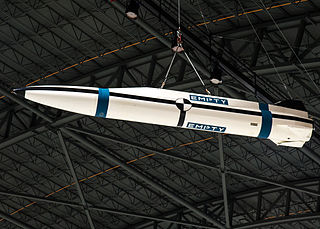
The AGM-131 SRAM II was a nuclear air-to-surface missile intended as a replacement for the AGM-69 SRAM. The solid-fueled missile was to be dropped from a B-1B Lancer, carry the W89 warhead and have a range of 400 km. However, the program was canceled by President George H. W. Bush for geopolitical reasons just as the first flight-test missile was delivered.

The Hughes AIM-47 Falcon, originally GAR-9, was a very long-range high-performance air-to-air missile that shared the basic design of the earlier AIM-4 Falcon. It was developed in 1958 along with the new Hughes AN/ASG-18 radar fire-control system intended to arm the Mach 3 XF-108 Rapier interceptor aircraft and, after that jet's cancellation, the YF-12A. It was never used operationally, but was a direct predecessor of the AIM-54 Phoenix used on the Grumman F-14 Tomcat.

The Hughes AIM-4 Falcon was the first operational guided air-to-air missile of the United States Air Force. Development began in 1946; the weapon was first tested in 1949. The missile entered service with the USAF in 1956.

The AIM-26 Falcon was a larger, more powerful version of the AIM-4 Falcon air-to-air missile built by Hughes. It is the only guided American air-to-air missile with a nuclear warhead to be produced; the unguided AIR-2 Genie rocket was also nuclear-armed.
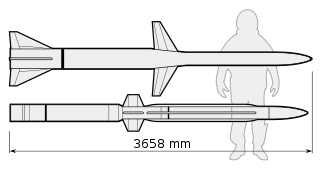
The AIM-152 AAAM was a long-range air-to-air missile developed by the United States. The AIM-152 was intended to serve as the successor to the AIM-54 Phoenix. The program went through a protracted development stage but was never adopted by the United States Navy, due to the ending of the Cold War and the reduction in threat of its perceived primary target, Soviet supersonic bombers. Development was cancelled in 1992.

The AGM-78 Standard ARM was an anti-radiation missile developed by General Dynamics, United States. It was built on the airframe of the RIM-66 Standard surface-to-air missile, resulting in a very large weapon with considerable range, allowing it to attack targets as much as 50 miles (80 km) away.

Popeye is a family of air-to-surface missiles developed and in use by Israel, of which several types have been developed for Israeli and export users. A long-range submarine-launched cruise missile variant of the Popeye Turbo has been speculated as being employed in Israel's submarine-based nuclear forces. The United States operated the Popeye under a different designation according to US naming conventions as the AGM-142 Have Nap.

The GAM-63 RASCAL was a supersonic air-to-surface missile that was developed by the Bell Aircraft Company. The RASCAL was the United States Air Force's first nuclear armed standoff missile. The RASCAL was initially designated the ASM-A-2, then re-designated the B-63 in 1951 and finally re-designated the GAM-63 in 1955. The name RASCAL was the acronym for RAdar SCAnning Link, the missile's guidance system. The RASCAL project was cancelled in September 1958.
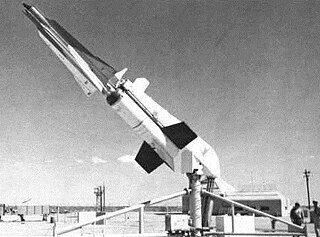
Typhon was a missile system developed by the United States Navy in the late 1950s, intended to serve as an integrated air-defense system for Navy fleets. Consisting of the SAM-N-8 Typhon LR, later designated RIM-50A, and the SAM-N-9 Typhon MR, later RIM-55A, paired with the AN/SPG-59 radar system, the cost of the Typhon system led to it being cancelled in favor of the Standard Missile program.
